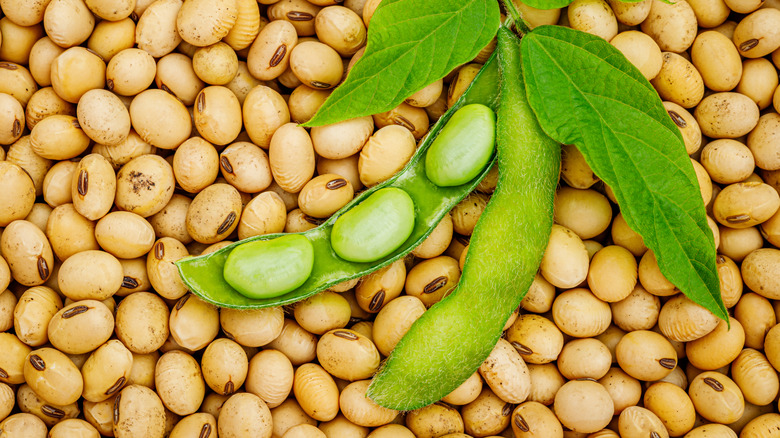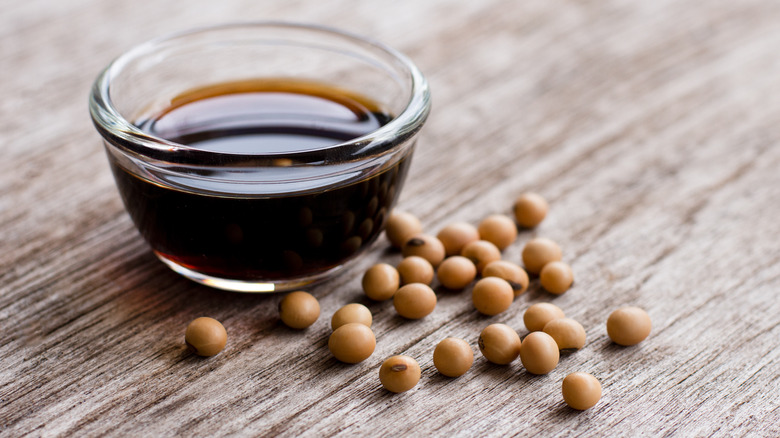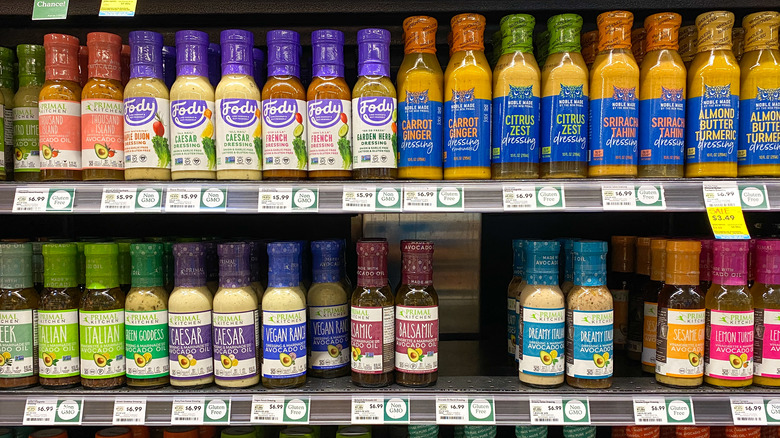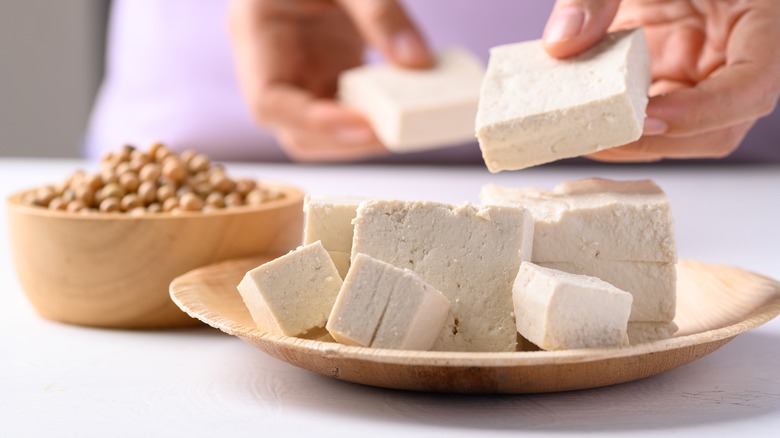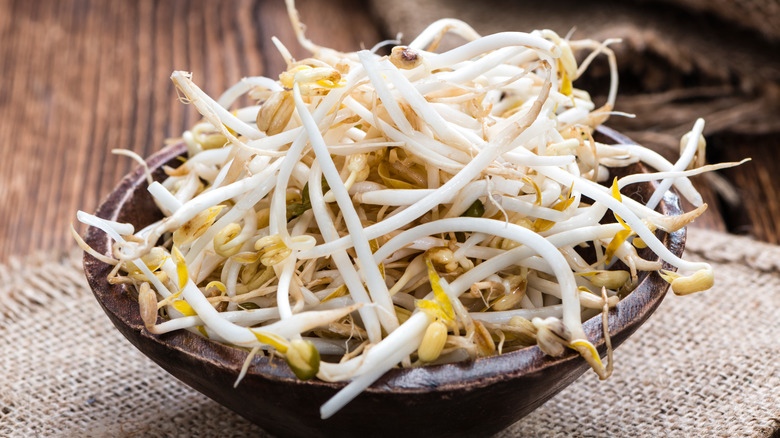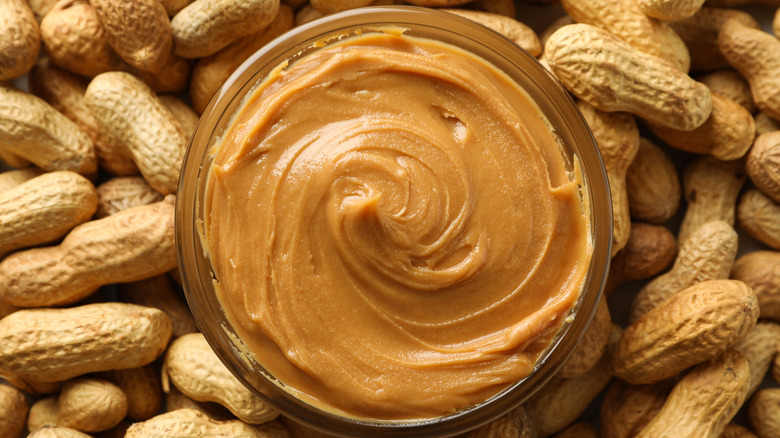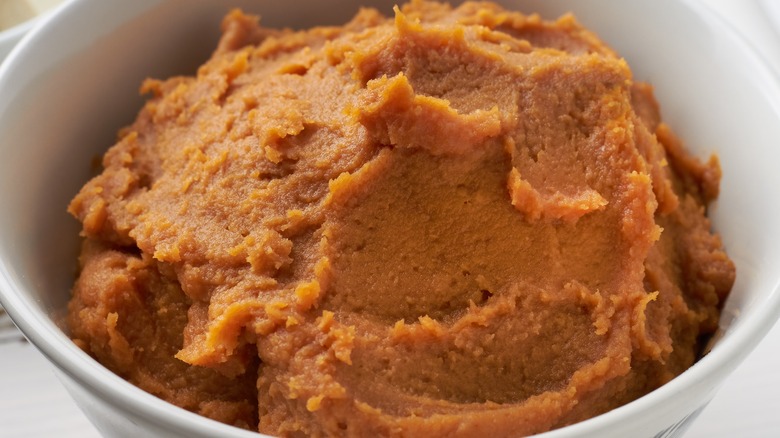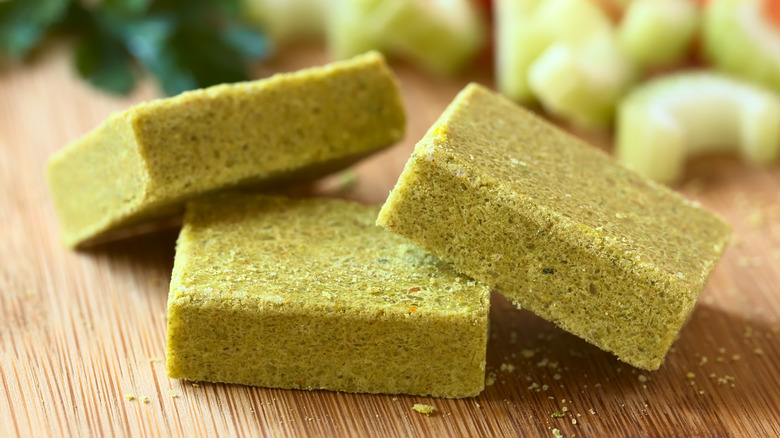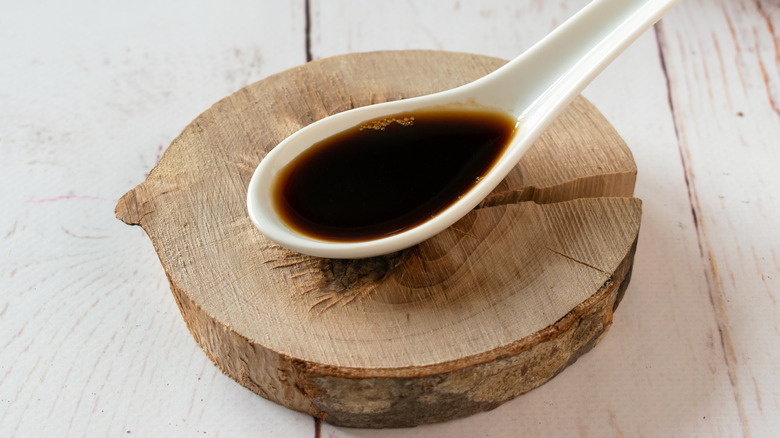14 Foods To Avoid If You Have A Soy Allergy
You'll find soy pretty much anywhere you'll find food. A staple ingredient in many Asian cuisines, soy started to become more prevalent in the United States in the mid-20th century, and thanks to its ability to provide a non-meat protein source and its potential health benefits, it's been a much-loved component of vegetarian and non-vegetarian dishes alike for generations (per Food Insight).
But as with any food source, soy can have its downsides – and for those with soy allergies, the ubiquity of soy and soy-derived products in food presents a huge problem. Soy allergies affect up to 0.5% of the general population, and are way more common among children, according to research published in Clinical Reviews in Allergy & Immunology. Like other allergies, symptoms can range from mild itching and hives to dangerous and life-threatening reactions including fainting, breathing issues, and anaphylaxis (per the Cleveland Clinic).
That's why it's highly important to identify where soy might be lurking in your food. And that's where we're stepping in, to help you avoid some key items on the shelf if you have a soy allergy.
Soy sauce
While it probably comes as no surprise, soy sauce is firmly off the menu for people who have a soy allergy. The sauce, a bottle of which likely sits in most pantries across the world, is made by taking soaked and steamed soybeans, combining them with wheat and salt, and then fermenting the mixture until it gains its uniquely briny, tangy flavor, as WebMD explains. While this naturally means that it contains levels of soy that make it unsuitable for those with soy allergies, the wheat in the sauce also means that it should be avoided by anyone who can't tolerate gluten (per Healthline).
Unfortunately, the sheer omnipresence of soy sauce means that although it's generally possible to avoid foods that contain it, it can be tricky for some folks to know how to emulate its unique taste in dishes. But you're in luck! There are a plethora of seasoning sauces out there that provide a soy-free alternative to the deep flavors of soy sauce. Healthline recommends throwing in coconut aminos, liquid aminos, fish sauce, Maggi seasoning, or Worcestershire sauce in place of soy sauce in any recipe that calls for it.
Some salad dressings
With some foods, the presence of soy is pretty clear — but with others, the ingredient can sneak in where you least expect it. Unfortunately, this is the case with some salad dressings, which can have soy added to them during the production process, according to WebMD. Brianna's Homestyle Asiago Caesar Dressing, for example, contains two separate soy-derived ingredients in its formula, with both soy sauce and hydrolyzed soy protein showing up in the creamy sauce (per Walmart).
As soy gives a kick of umami and saltiness, it's easy to see why it'd show up in commercially available salad dressings. But the good news is, there are plenty of salad dressing options out there that omit soy entirely. Brianna's actually has a different product, their Homestyle Poppy Seed Dressing, which is soy-free. Other options like Primal Kitchen's Greek Vinaigrette, Annie's Homegrown Lemon and Chive Dressing, and Garlic Gold Meyer Lemon Vinaigrette will all deliver premium flavor minus the soy (per One Green Planet). And of course, you can always whip up your own, with a simple vinaigrette of olive oil and lemon juice or white wine vinegar. Who says salad dressings have to be fussy?
Tofu
In its naked state, it might be hard to discern that tofu is made of soy. After all, it doesn't bear much resemblance to the shiny little green beans. But made from soy it is, folks, and it should be outright avoided if you have a soy allergy.
Tofu is in fact made from soya milk, by curdling the liquid and then pressing it into the firm white block we recognize so well, in a manner that's similar to the way cheese is made (via BBC Good Food). While tofu is a nutritional powerhouse of antioxidants and protein, that won't be much comfort to people who are allergic to the stuff.
As tofu preparations vary from silken and soft to firm and chewy, there's no one-size-fits-all approach to replacing it in meals. But for silken tofu, using dairy products like sour cream or ricotta may be a good substitute, according to The Kitchn. For firm tofu, a straight swap might be trickier, but soy-free seitan or alternatives like mushrooms and chickpeas could do the trick.
Beansprouts
Where did you think beansprouts came from? Probably from a bean, right? You don't have to be a quiz master to have figured that one out — but it's the type of bean that makes them tricky for people with a soy allergy.
Beansprouts are generally available in two varieties: grown from mung beans, which you'll generally recognize by their green ends, and soybeans, which produce sprouts that are larger and have a yellow tip (via BBC Good Food). It's the soy variety that makes them unsuitable for those with soy allergies (per Verywell Health).
But if you're thinking, "No problem, I'll just get the mung bean variety instead," we'd advise you to think twice. Thanks to the potential for cross-reactivity, mung bean sprouts may also cause an allergic reaction if you have a soy allergy thanks to their legume status, according to the NY Allergy & Sinus Centers. That's why it's highly important to check with your doctor before introducing any soy-adjacent foods into your diet, and why it may be safer to just avoid both kinds of beansprout.
Any foods with MSG in them
Wow, MSG sure gets a bad rep, doesn't it? The naturally-occurring ingredient also known as monosodium glutamate has been the source of controversy for decades thanks to its supposed allergenic effects (per Healthline).
But putting the potential for MSG allergies aside for one second, the ingredient poses a different problem entirely for people who can't eat soy, and it may be useful for those folks to avoid eating food with MSG in it entirely, says WebMD. While this is less to do with the fact that MSG interacts with soy allergies, it's more because foods that contain monosodium glutamate also frequently contain soy, like our old friend soy sauce. Thus, MSG's presence might be an indicator of soy in the food as well (per Healthline).
We're happy to say, though, that what is less of a worry is MSG causing an allergic reaction. Despite endless hearsay about monosodium glutamate's negative health effects, MSG allergies are a myth, and given the tiny amounts of the ingredient in most dishes, the chances of experiencing a reaction due to sensitivity when eating smaller quantities of MSG are pretty low.
Peanut butter
Peanut butter is a firm favorite for people from infancy to old age. But it may not be as appetizing for folks who have soy allergies, thanks to the presence of soy in certain brands of peanut butter, as Verywell Health points out.
One source of soy in peanut butter comes from soybean oil, as seen in Skippy Creamy Peanut Butter (via Walmart). Soybean oil in food can be somewhat of a question mark for folks avoiding soy thanks to an allergy. Although highly refined soy oil generally doesn't instigate any reaction due to its preparation process, cold-pressed or extruded soy oils may still contain traces of the ingredient (per FARE).
It's recommended that you discuss with your doctor the potential for consuming soybean oils with a soy allergy before doing so in any product, including peanut butter. And remember, although certain peanut butter brands favor using soybean oil in some of their products, it doesn't mean that all products in the company will contain the ingredient, with Trader Joe's, Skippy Natural, and Peter Pan peanut butter all having soy-free options (via Beyond Soy).
Miso
A member of the family of soybean-derived food ingredients, miso is a no-go for those with soy allergies. The umami-packed fermented paste, of which there are over 1,000 variations, is created by aging a combined mash of soybeans, some type of grain, salt, and koji, a fungus that ushers in the fermentation process (per The Spruce Eats).
The uniqueness of the paste might cause you to assume that it's hard to find a suitable replacement for it in a meal. But luckily, the culinary wizards out there have it covered. Non-soy-based misos now exist and are pretty readily available, with pastes made from anything from sweet potato to chickpeas. Portland-based business Jōrinji, for example, offers these. "We had customers asking us to make a non-soy based miso, partly because their children were soy-allergic," says company boss Earnest Migaki to Bon Appetit. Particularly, their lima bean-based miso is a hit, with a delicate, sweet flavor that can take the place of regular miso in a variety of dishes. Ah, the wonders of the modern world!
Tempeh
In a world of meat substitutes asserting their dominance, tempeh stands tall. But like its meat-free cousin tofu, tempeh is made from soy. Originating in Indonesia, tempeh is fermented to achieve its unique taste, with semi-cooked soybeans mixed with rhizopus, a type of fungus, to create the firm block (per WebMD). As such, for those with soy allergies, it should be left out of the basket at the store.
Given tofu and tempeh's popularity in meat-free dishes and products, you can be forgiven for despairing slightly at the lack of options if you're allergic to soy. But we recommend giving seitan a try instead. Created by combining wheat gluten and water, seitan is naturally soy-free, and unless the product you choose contains soy as an additive — which is why it's always important to check the label, folks — you're good to go, says Healthline.
Seitan's protein level is roughly the same as what you'd find in an equivalent weight of chicken or beef, making it an easy swap. It's important to remember, though, that seitan is unsuitable for anyone with gluten intolerance or allergy.
Textured vegetable protein (TVP)
The name "textured vegetable protein" (TVP) is pretty much as vague as they come, so if you've ever wondered what that strange abbreviation in your ingredients list actually is, we have the answer for you. It's soy! Well, most of the time, anyway.
TVP is created as a byproduct of soybean oil production, which leaves behind a protein-rich paste of mashed soybeans once the oil has been extracted, according to Healthline. Food manufacturers then take this paste, shape it into different dimensions, dehydrate it, package it up, and then put it on the shelves or in your food.
It's worth pointing out that TVP can be made from other things, like cottonseed, wheat, or oats. But soy is far and away the most common ingredient, and so for anyone with a soy allergy, it's best left avoided. Using jackfruit as a meat substitute can be a good choice instead of TVP — while it may not deliver the same protein hit, it's a versatile and exciting ingredient that can take the place of meat for anything from pulled pork to an imitation sushi bowl (per Good Housekeeping).
Certain types of bouillon
What's in that little cube of bouillon that you throw into your soups and stews? If you're allergic to soy, you might want to check. Certain types of instant bouillon contain several soy-derived products that make them unsuitable for anyone who can't eat the ingredient. Wyler's Instant Bouillon Chicken, Herbs & Spices Flavored Cubes, for example, actually contain three different ingredients containing soy, hydrolyzed soy protein, flavorings with soy in them, and soy lecithin (per Walmart). A similar Wyler's product, their Instant Bouillon Chicken Flavored Powder, also contains several soy products, as Walmart shows.
It may be helpful to know, however, that while soy lecithin does contain traces of soy, it's usually not enough to induce an allergic reaction in most people, states the University of Nebraska-Lincoln's Department of Food Science and Technology. The other soy-based ingredients that sometimes show up in bouillon are best avoided, though.
A simple solution? Make your own! Homemade chicken broth can be easily made by boiling together chicken legs and thighs, an onion, some bay leaves, salt, water, and vegetable oil, in a recipe that takes little more than an hour, as The Spruce Eats shows.
Tamari
With soy sauce being a key component in a huge number of dishes, you might be wondering whether tamari, a close relative of the seasoning, might be soy-free (and, indeed, what the difference is between the two in the first place).
Unfortunately, tamari is indeed a soy-based sauce in its own right and is produced from similar ingredients to soy sauce, albeit via different methods, says The Spruce Eats. While soy sauce is made by fermenting soybeans with grains and salt, tamari is created from the leftover liquid from the production of miso paste. The result is a similar-looking sauce that's slightly thicker and has a richer taste, and is ideal as a dipping sauce, whereas soy is more at home as an ingredient in dishes.
One thing to bear in mind with tamari, as well as with soy, is that it contains wheat and therefore gluten. This is something which can cause folks who have a gluten intolerance to assume that they also have a soy allergy, due to being unaware of the wheat's presence in the sauce (per Verywell Fit). If you do have a bona fide soy allergy, however, tamari is best substituted with something else entirely. Try using coconut aminos in dishes that call for tamari. While having a taste that's similar to soy, it's both soy-free and gluten-free — and as a bonus, it's way lower in salt, says WebMD.
Foods containing hydrolyzed soy protein (HSP)
If you're allergic to soy, it's regrettably not the case that you just need to avoid edamame beans, soy sauce, and miso. How simple it'd be if that were all it took, eh?
Unfortunately, a great many products containing soy sneak their way into ingredients lists — and hydrolyzed soy protein, or HSP, is everywhere. Created by taking soy protein particles and breaking them down via a chemical process until the smaller amino acids remain, HSP can generally give a "meatier" flavor to dishes, and is commonly used as a flavor enhancer (per Livestrong).
Naturally, the food industry couldn't let this secret go to waste, which is why HSP can end up in an incredibly wide variety of things on the shelf. In the processed food section, you may spot HSP on the ingredients list of stews, sauces, chili, soups, hot dogs, and meat products, and you may even find it in pretzels or potato chips, other snacks, and certain dips (via CBC). Quite a lot, right? Your best method to avoid HSP is to check the allergens section each time you add something to your basket.
Energy bars
Energy bars are the ideal snack for a quick boost of vigor before a workout (or at the start of a long day, the end of one, on your lunch break, picking up your kids — okay, yes, we like energy bars, not sure if you can tell). For people with soy allergies, however, they may be less ideal.
A large number of energy bars contain soy protein isolate, says Runner's World, which could potentially trigger an allergic reaction. And for people who don't have a soy allergy, you might want to rethink eating some energy bars in the first place, as the presence of "soy protein isolate" doesn't necessarily mean they're healthy. "All soy is not created equal, and this is seriously processed soy junk," says "The Little Book of Thin" author and registered dietitian Lauren Slayton. Okay, maybe we don't like them so much after all.
Fortunately, though, there are energy bars out there that are not only soy-free, but also sit on the healthier side of the spectrum. Try an Orgain Organic Chocolate Chip Cookie Dough Protein Bar, recommended by Women's Health Magazine for its super-clean nutritional profile. "These delicious Orgain bars are organic, vegan, non-GMO and made without gluten, soy and dairy ingredients," according to registered dietitian Acacia Wright. Sounds good to us!
Candy
Okay, sorry about this one, folks. But if you've got a soy allergy, you might want to be careful with the candy you consume.
Sadly, soy can sneak its way into a pretty wide variety of common candies out there, including M&M's, Hershey's bars, Kit Kats, Twix's, Butterfinger's, and Tootsie Rolls, says Verywell Health. Although it's useful to point out that for a lot of these products, the soy in question is either from soybean oil or soy lecithin (refined ingredients that may not bear a risk for those with soy allergies, per the Asthma and Allergy Foundation of America), you should still check with your doctor before eating them.
But to prove that we're not entirely killjoys who are determined to banish candy from your cupboards forevermore, the good news is that there are plenty of candy options that are safe for people with soy allergies. Nerds, Red Vines, Sour Patch Kids, Starburst Originals, and Atomic Fireballs are just some of the candies that you can eat safely, according to Pop Sugar.

